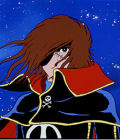There are certain manga and anime creators which despite (or possibly because of) their very Japanese and somewhat niche flavor have gained considerable popularity all over the world. Maybe the fact that such iconic anime as Kimba – The White Lion, Speed Racer or Star Blazers have somehow reached American and European television in the 70’s and 80’s could account for this to some extent. In those times they were simply too unique in comparison to western cartoons not to draw attention of the kids that came across them. Also, they encompassed much wider range of emotions, making for much more immersive and deep experiences.
In the current times even with updated graphics most children would deem those series (maybe with the exception of Speed Racer) too strange and moody to be likable. Yet the “damage” is already done – there exists in the West a widespread recognition and demand for some of the less accessible and gritty anime work (they were made in a way to be interesting also for older audiences), which in consequence allowed also myself to become acquainted with them. So for instance the aforementioned Star Blazers series which was a modified version of Uchuu Senkan Yamato ( Space Battleship Yamato) after a little bit of research can lead its fans directly to Uchuu Kaizoku Captain Harlock (Space Pirate Captain Harlock) and Ginga Tetsudou 999 (Galaxy Express 999). These three titles are the most important and popular creations of a man(gaka) called Leiji Matsumoto whose creative contributions to anime are often compared in Japan to the likes of Osamu Tezuka or Hayao Miyazaki. The following is supposed to be a short introduction to this author’s work.

Matsumoto’s style can not be easily described, neither in the storytelling, nor in its visual aspect. His dedicated genre is space opera, but he often goes with it in the direction of more traditional sci-fi, folk fairy tales, or melodrama. His favorite themes are: freedom, war, tragic death, the value of peace, spiritual beauty, manly friendship and tragic, short-lived love. As for the sci-fi part, he devotes considerable thought to space exploration (especially using ancient locomotion devices modified into the most technologically advanced spaceships), as well as to cyborgization of the body and experimentation with the limits of one’s humanity. Yet the sometimes dreaded machines have their souls as well – many stories seem to suggest.
In regard to Matsumoto’s drawing style, his character designs are very different from the typical manga style. Humans are divided between handsome, tall and slender figures and dwarfs with caricatural features. In addition, almost all woman characters’ looks are based on the French actress Marianne Holt (whose appearance supposedly made a huge impression on young Matsumoto). Other notable Matsumato’s obsessively repeated trademarks include prominent, cartoony scars and long hair covering one of the eyes of the character. The images are usually epic and highly expressive with monumental ships cutting through the seas of space, yet with understated pauses between huge events. During those reflective scenes the characters tend to receive Sergio Leone like face close-ups which showcase strange, sad eyes.

Finally, there is the one quality about Leiji Matsumoto’s creations that leads to the greatest amount of arguments between people interested in them . Through some quite ingenious concepts all the contents of Matsumoto’s huge body of work exist in the same plane of reality (named by fans as Leijiverse) and he loves constantly bringing back some of his trademark characters in unrelated adventures. The trick is that no two independent stories are fully congruent with each other, but express different possibilities of states of things (the so called possible worlds). So in each new tale if you see a familiar character you will learn at least slightly different version of his backstory. You can forget about a canon of stories or chronology of events outside a specific production.
All those special quirks certainly build a very unique atmosphere differing greatly from anything that can be found elsewhere. From time to time I’ll add reviews of specific Matsumoto’s works, especially the most classic ones, and explore the Lejiverse in detail.
Note: The images from anime above show Captain Harlock – the essential Matsumotoesque hero – and Maetel – the essential Matsumotoesque heroine.

2009/02/07 at 16:55
I’ll be looking forward to more posts on the Leijiverse. Have you actually ever seen Marianne Holt? (I haven’t). Does she look Matsumotoesque?
2009/02/07 at 18:46
Thanks. I’ll be posting a review of Uchuu Kaizoku Captain Harlock later this month.
I’ve seen fragments of the movie Marianne of My Youth, but to be honest I didn’t see that much semblance between Holt’s facial features and those of Matsumoto’s heroines – she doesn’t look as unique. On the other hand, there was a dreamy atmosphere and nostalgia surrounding her character which felt very much Matsumotoesque.